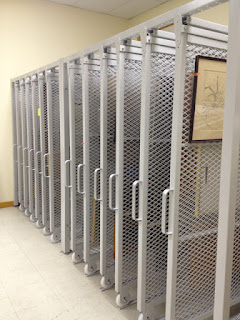Several years ago, I had the opportunity to consult at the Maine Historical Society in Portland, Maine. They created wonderful protective storage for their framed collections in a closest that was underutilized because it was "out of the way". The closet space seemed perfect to be reconfigured into small segmented storage for framed artifacts. It can be described as a variation on bin storage. Bin storage for framed collections has been around for a long time and is highly recommended. And while it is a good choice, care is needed to ensure that all parts of the framed collection remain protected; This also means the frames themselves.
It is true that at times, the document or portrait is considered the important part of the artifact, consequently the frames are not sufficiently protected. Also, with large bin storage many frames can be housed in a single bin and the items can lean against one another. But most importantly; in a highly-populated bin, when one item is selected, several artifacts are handled. (reducing handling of artifacts is always good practice, read our previous post about lowering the handling of other artifacts, especially those that are wrapped or boxed). In the photo below, large bins are utilized, archival materials are used to interleaf the frames, and corners are protected with padding. A sheet of Ethafoam covers the "floor" of the bins, and it protects the bottoms of the frames.
In the closet at the Maine Historical Society, the segmented spaces are evenly divided in small sections to allow only one to two framed items, perhaps three if the frames were very thin (image below). The sections are labeled for identification.
Padding with Volara sheeting is applied at both the lower and upper horizontal supports. Each framed item is sandwiched between foam-core board, which is very sturdy for interleaving.
 |
| Each area is labeled, so the artifact you are looking for is easier to find and therefore handling is minimized. |
 |
| Here you can see the foam core board separators. |
 |
| Here you can also see the padded lip of the storage opening. |
Another system using Metro International wire chrome movable units is used at the Roosevelt / Vanderbilt, National Park Service's new storage facility in Hyde Park, NY. The system is archival and it is space conscious. This system also allows for custom-sized sections for the bin. The size of the bin should be noted to determine if excessive handling or "paging" through framed items is done before the item being searched for is located. Also, is there any risk of the items being bumped from the side because the rack is accessible from both sides?
 |
| In this type of bin storage each item is separated so that it will not be in contact with another piece. |
 |
| Another view of the sliding unit. This hanging storage is completely archival. It is costly and takes up a large amount of space but the framed works are stored perfectly. |
 |
| This hanging storage slides on set tracks and there is no risk for one unit hitting another. |
 |
| close up of the sliding tracks from the above unit. |
 |
| Another take on hanging storage. Care needs to be taken that the frames cannot hit each other as the storage is moved. Here the units move like the pages of a book. |
 |
| A tremendous amount of hanging storage. |
 |
| This large hanging storage area is wall mounted and composed of archival components. It uses a great deal of wall space. |
 |
| These framed items are placed in a hanging storage system that is compact and thus makes great use of precious storage space. The use of wood needs to be considered because of its acidity. |
 |
| Large ornate frames like these are well suited to hanging storage. |
Determining the best solution for framed storage is determined by many factors:
- Space
- Budget
- Amount of framed items needing storage
- Size of the items
- Ornateness of the frames,
- Media used (pastels for instance should not be subjected to vibration from moving racks because the media could be dislodged from the surface of the work, causing it to fall to the bottom of the frame; see image below).
Each institution will be different because of their unique needs. You may or may not have a wonderful little closet to retrofit, but you do know your collection and you know your storage space. Don't be afraid to think outside of the box and create the best frame storage for your institution.
Need some extra advice? An online guide of types of framed art and how they should be stored can be found through the Minnesota Historical Society. They also have wonderful guidelines for all sorts of things, check them all out. Want an expert collection care consultant to come and help you figure this out? Call an art conservator.
_____________________________
Gwen Spicer is an art conservator in private practice. Spicer Art Conservation specializes in textile conservation, object conservation, and the conservation of works on paper. Gwen's innovative treatment and mounting of artifacts is unrivaled. To contact her, please visit her website.




Wonderful and informative post! Your detailed approach to storing framed artworks safely is truly valuable for both collectors and professionals. The emphasis on environmental factors and structural support highlights the importance of proper Picture Framing beyond just aesthetics. Thanks for sharing such practical insights!
ReplyDelete